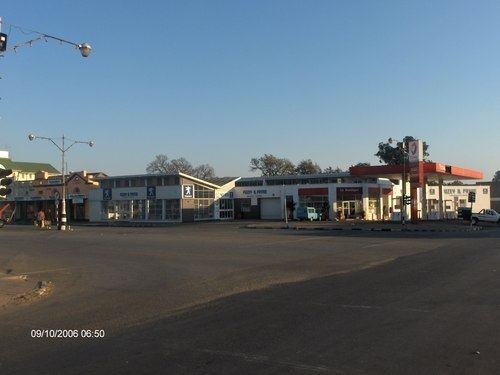Country | Population 140,806 (2002) Founded 1894 | |
 | ||
Map of Gweru
Gweru (called Gwelo until 1982) is a city near the centre of Zimbabwe. It is the administrative capital of the Midlands Province, one of ten provinces in Zimbabwe. It became a municipality in 1914 and achieved city status in 1971. The name changed from Gwelo to Gweru in 1982. Before becoming a municipality, Gweru was known as "The Steep Place" after the Gweru river's high banks when it was first settled by the Matabele. Founded in 1894 by Dr. Leander Starr Jameson, modern Gweru was initially established as a military outpost.
Contents
- Map of Gweru
- Antelope park gweru zimbabwe africa
- Puppeteer mudzongachiso at work along gweru streets
- Railway
- Roads
- International relations
- Education
- Sights
- References
The Nalatale and Danangombe archaeological enclosures lie nearby, the former known for its patterned brickwork, the latter for its Portuguese remains. The remains at these sites date back to as early as the Torwa state during the 17th century, the most substantial being a four hundred-year-old stone wall decorated with motifs known to the tradition of stone-building in Zimbabwe. The surrounding area has rich deposits of gold, chrome, iron, asbestos and platinum and supports several mines.
Gweru has become one of Africa's busiest trade centers thanks to its production of textiles, dairy foods, footwear, and building materials. Gweru is also well known for vibrant farming activities in beef cattle, crop farming, and commercial gardening of crops for the export market.
Antelope park gweru zimbabwe africa
Puppeteer mudzongachiso at work along gweru streets
Railway
Railways arrived in Gweru in 1902. National Railways of Zimbabwe have the country's largest marshalling yard, Dabuka, on the south side of Gweru. Dabuka plays a pivotal role in rail movement in the country as it is the central hub of the rail links to Mozambique in the east, South Africa in the south and Botswana and Namibia in the south west, lying on the Bulawayo - Harare Line.
Roads
As a central city (hub), it has direct links to all the other cities and towns of Zimbabwe. It is 164 km from Bulawayo, 183 km from Masvingo, 471 km from Beitbridge, and 275 km from Harare.
Road names used are by destination only, for example the Harare-Gweru Road. There are only mainroads, no highways or freeways.
International relations
Gweru shares an international relationship with the town of Basildon, (Essex, United Kingdom). And Manchester, New Hampshire.
Education
The primary and secondary system of education has not changed much in structure for several decades.
Group A
Group B
Group A
Group B
Commercial education was not easily available to the majority of Gweru residents especially before independence. There was a surge of new colleges after 1980 when Zimbabwe gained independence and also when commercial courses became a popular requirement in industry.
Midlands College of Commerce It provided courses in most commercial and practical subjects popular during that era for example: typing, bookkeeping, dress-making and shorthand. These were examined by the UK-based Pitman Examinations Institute. This college stopped operating in the mid-1990s following the death of W.H Shumba in 1994.
After 1980 other colleges were soon established:
Sights
The Boggie Clock Tower, located at the intersection of Main Street and Robert Mugabe Way, was built in 1928 in memory of Major William James Boggie. The clock tower is one of the city's most famous landmarks.
